The 1940s was a time of rationing, creativity, and sometimes questionable culinary choices. During World War II, home cooks had to make do with limited ingredients, leading to some interesting—and occasionally stomach-turning—recipes. While some wartime classics have stood the test of time, many others are best left as historical curiosities rather than dinner options.
1. Liver Loaf
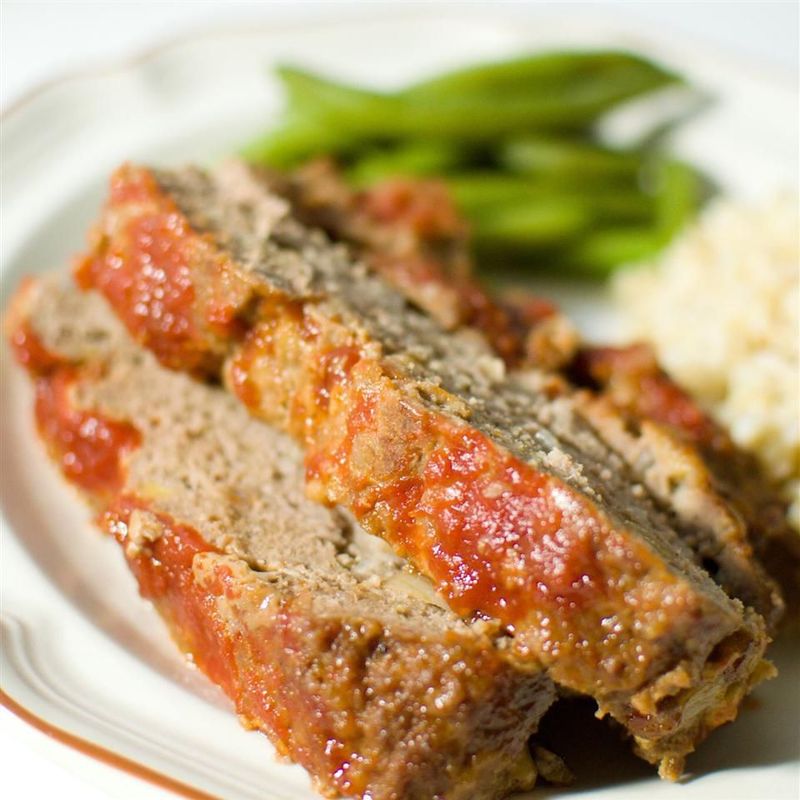
During wartime rationing, liver loaf appeared on dinner tables across America, not because people craved it, but because organ meats weren’t rationed. Families made do with what they had, turning ground liver into a sliceable meatloaf-style dish that could stretch for several meals.
The metallic, iron-rich flavor overpowered even the most generous additions of onions and spices. Children would push it around their plates, hoping it might somehow disappear if they stared at it long enough.
Served cold the next day between bread slices, liver loaf sandwiches became the dreaded lunch item that kids would trade for almost anything else. The rubbery texture and strong flavor have rightfully been relegated to the dustbin of culinary history.
2. Creamed Chipped Beef on Toast (“S.O.S.”)
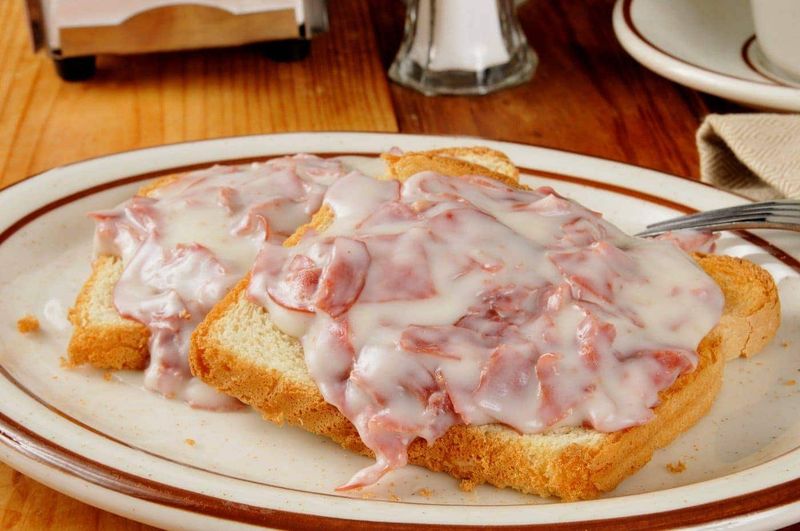
Military veterans still shudder at the mention of this infamous dish, nicknamed “Sh*t on a Shingle” for good reason. Thin slices of salted, dried beef swimming in a thick, pale gravy atop soggy toast created a meal that looked as unappealing as it tasted.
The overwhelming saltiness assaulted taste buds while the grayish-white sauce offered nothing but a pasty, flour-laden texture. Soldiers ate it because they had no choice, and sadly, the recipe followed them home after the war.
Families across America endured this budget-friendly but flavor-poor meal for years afterward. Despite nostalgic attempts to revive it, this dish remains a culinary casualty best remembered in war stories rather than recipe books.
3. Gelatin Salads
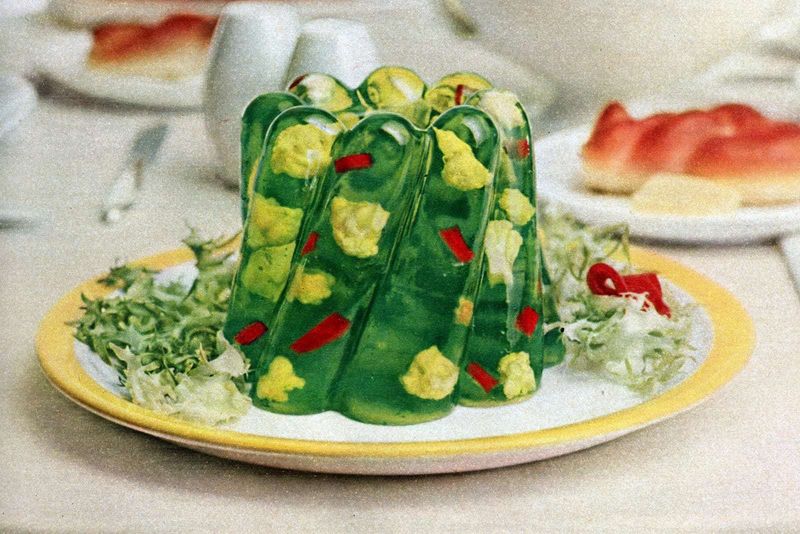
Nothing screams 1940s food experimentation quite like suspending random ingredients in jiggly gelatin and calling it a salad. These wobbly creations featured everything from shredded vegetables to canned tuna, all trapped in brightly colored Jell-O like prehistoric insects in amber.
Imagine biting into what appears to be a fruity dessert only to encounter chunks of celery, olives, or—heaven forbid—canned salmon. The textural confusion alone was enough to trigger mealtime meltdowns.
Particularly notorious was the “Perfection Salad,” which combined cabbage, celery, and pimentos in lemon gelatin. These concoctions appeared at potlucks and dinner parties where guests politely nibbled while plotting to feed their portions to the family dog under the table.
4. Spam with Fruit Cocktail
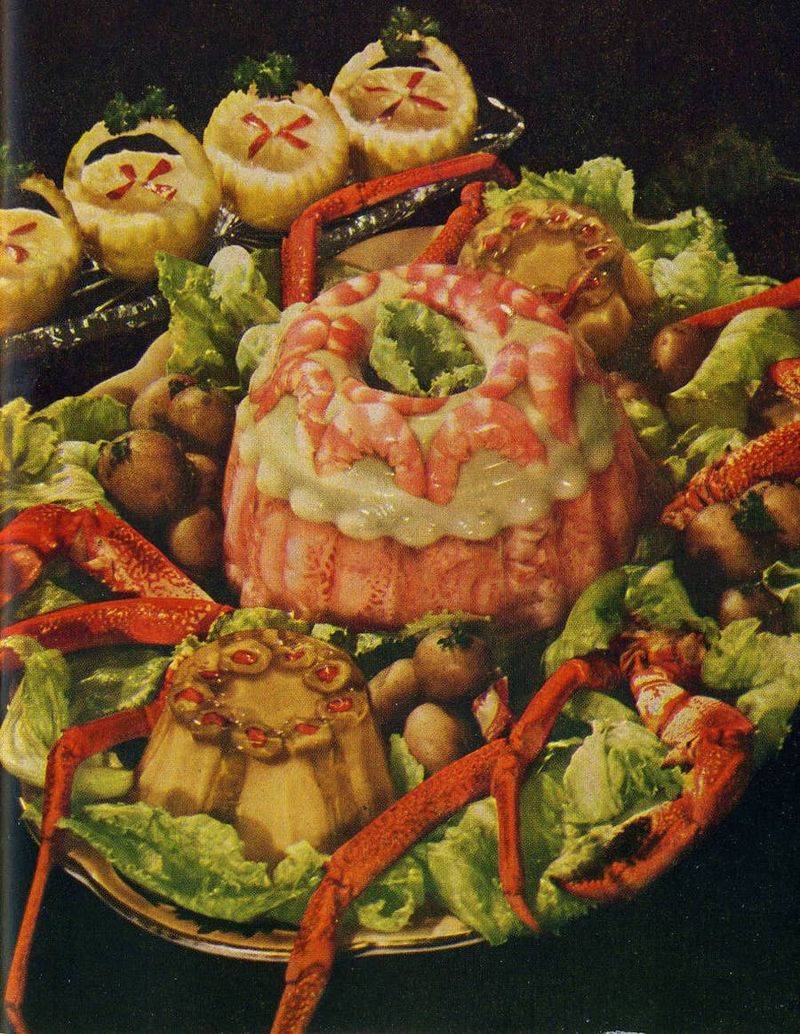
Born from desperate pantry combinations, this bizarre pairing attempted to dress up military surplus meat for civilian dinner tables. Pink slabs of fried Spam would be arranged on a plate, then crowned with syrupy canned fruit cocktail—those technicolor chunks of pears, peaches, grapes, and obligatory red cherries.
The warm, salty processed meat created a disturbing flavor contrast with the sweet, syrupy fruit. Home economists of the era promoted this as a “Hawaiian-inspired” dish, though actual Hawaiians deserve no blame for this culinary crime.
Recipe pamphlets suggested this as an “elegant” dinner party option, proving that wartime standards for elegance were dramatically different from today’s. The dish represents perhaps the most egregious example of 1940s food philosophy: anything can be combined with anything else, regardless of flavor compatibility.
5. Tomato Aspic
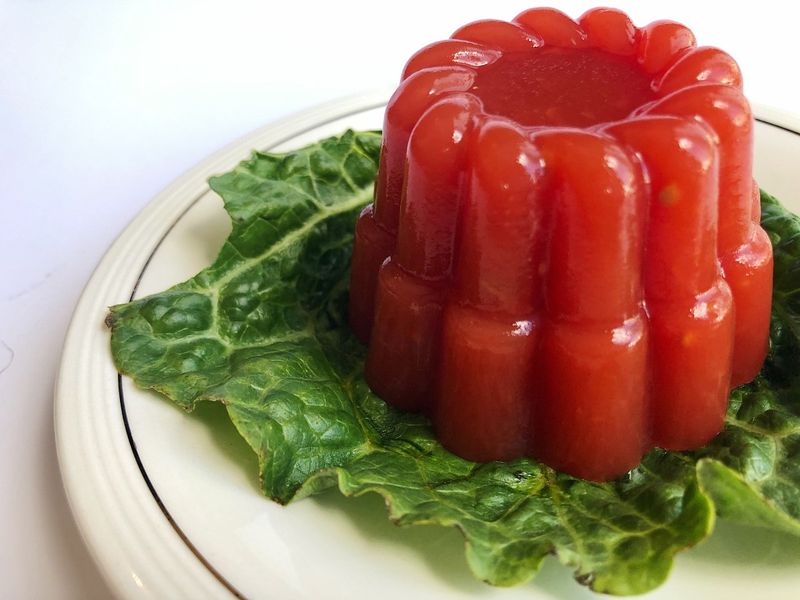
Grandmothers across America once prided themselves on their tomato aspic, a savory jello that quivered ominously on special-occasion dining tables. Made by suspending tomato juice with gelatin, this ruby-red creation typically contained floating islands of celery bits, olive slices, and sometimes hard-boiled egg.
First-time eaters often mistook it for a sweet dessert, only to be shocked by the acidic, savory punch. The cold, slippery texture combined with the tangy tomato flavor created a sensory experience that few modern palates would tolerate.
Served on a lettuce leaf and topped with a dollop of mayonnaise, tomato aspic was considered the height of sophisticated dining in the 1940s. Today, it stands as evidence that our grandparents had significantly different ideas about what constituted a fancy salad course.
6. Victory Garden Casserole
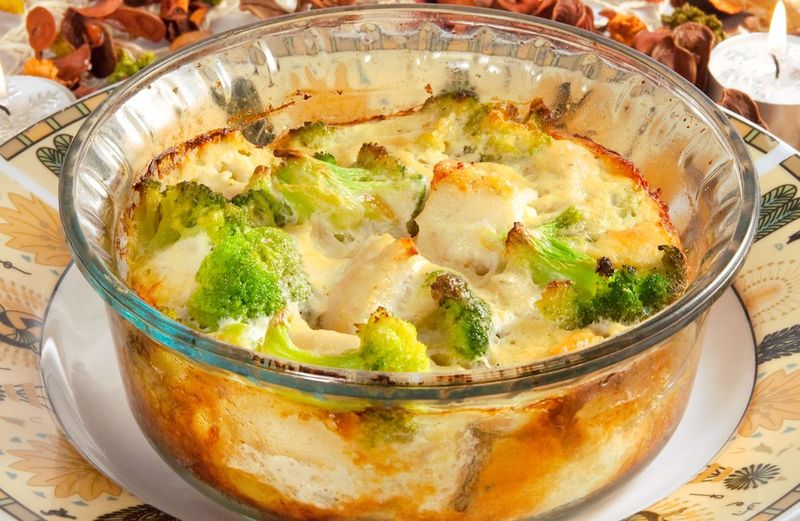
Patriotism took edible form in the Victory Garden Casserole, a dish that embodied the “waste not, want not” mentality of wartime America. Home-grown vegetables—typically whatever was overproducing in the backyard plot—were layered in a casserole dish with minimal seasoning and a sprinkle of whatever cheese could be spared from rationing.
The result was often a watery, bland amalgamation of overcooked cabbage, potatoes, and carrots. Without herbs and spices, which were hard to come by during wartime shortages, the dish relied on salt for flavor—and not much else.
Families dutifully consumed this soggy vegetable medley, bolstered by propaganda posters reminding them that cleaning their plates helped the war effort. Modern vegetable casseroles, with their flavorful seasonings and proper cooking techniques, bear little resemblance to their sad wartime ancestors.
7. Peanut Butter-Stuffed Prunes
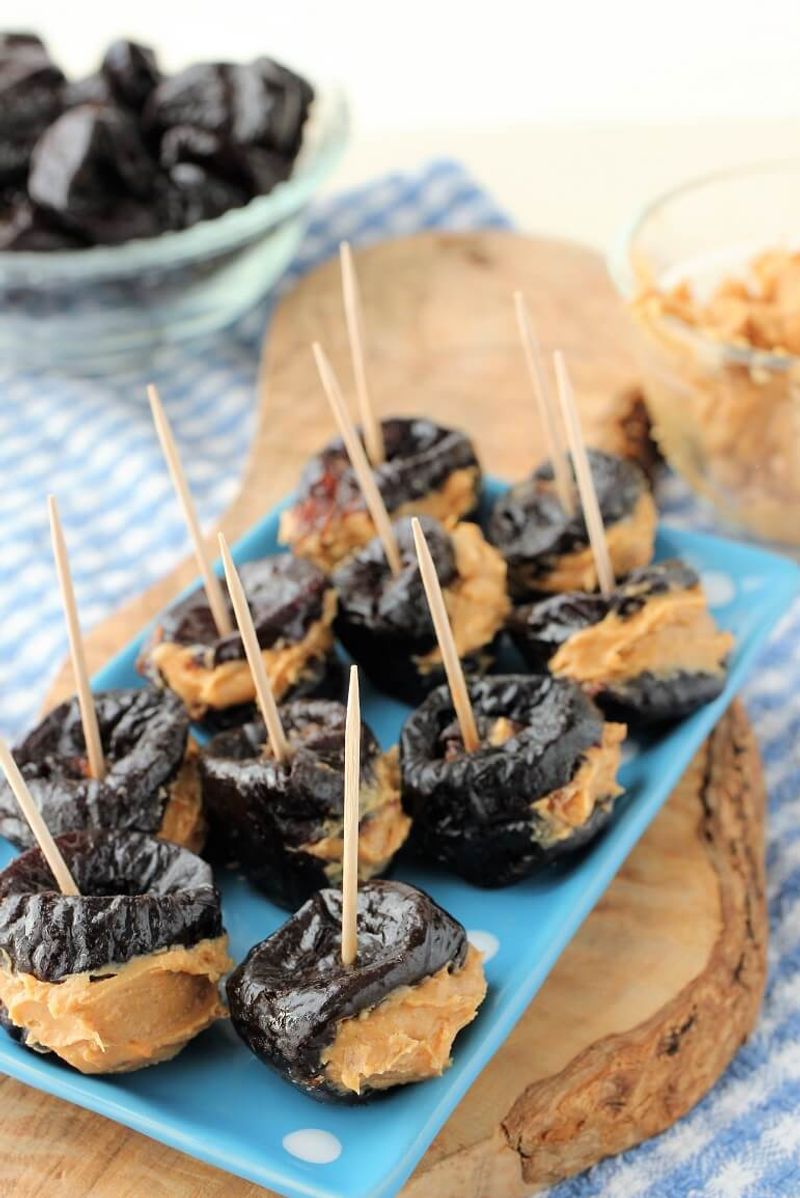
When wartime sugar rationing limited dessert options, creative housewives turned to this peculiar “treat” that satisfied neither sweet cravings nor snack desires. Dried prunes—already an unpopular food item among children—were pitted and stuffed with globs of thick peanut butter, creating a strange textural combination that pleased virtually no one.
Promoted in women’s magazines as a “nutritious energy snack,” these sticky, chewy morsels stuck to teeth and the roof of the mouth in equal measure. The dense peanut butter made the already-dry prunes even more difficult to consume without a large glass of milk.
School lunch boxes across America occasionally contained these as “healthy alternatives” to candy, leading to many playground trades where desperate children would exchange them for almost anything else. Modern parents, thankfully, have found more palatable ways to combine protein and fruit.
8. Mock Apple Pie (Ritz Cracker Pie)

When apple harvests were directed toward troops overseas, American ingenuity reached bizarre heights with the invention of Mock Apple Pie. This uncanny dessert used crushed Ritz crackers soaked in a lemon-flavored sugar syrup to mimic apple filling—a culinary sleight of hand that fooled the eyes but rarely the taste buds.
The crackers softened to a texture vaguely reminiscent of cooked apples, while cream of tartar and lemon provided tartness. Cinnamon and other spices completed the illusion, at least visually. One bite, however, revealed the truth to most discerning eaters.
Remarkably, this recipe appeared on Ritz Cracker boxes until the 1980s, long after actual apples became readily available again. A testament to American adaptability during hardship, this strange pie substitute nonetheless deserves to remain a historical curiosity rather than a regular dessert option.
9. Meatless Loaf
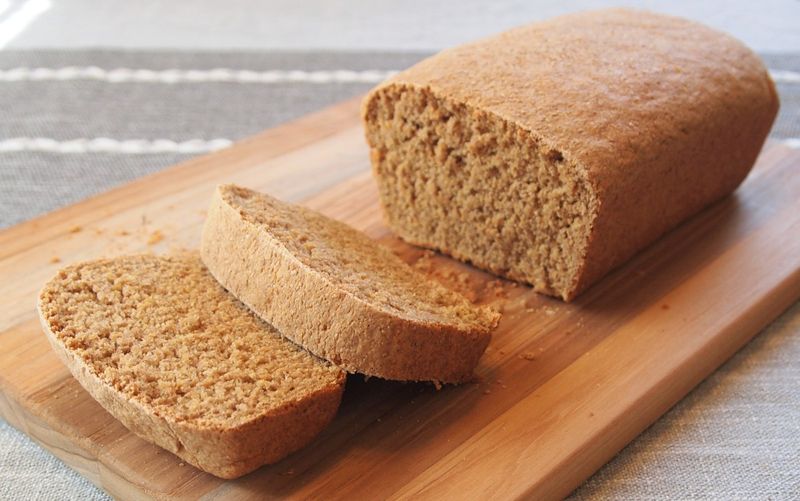
Before modern plant-based alternatives, there was the 1940s meatless loaf—a dense brick of oats, nuts, and vegetable scraps bound together with powdered eggs and breadcrumbs. Unlike today’s flavorful vegetarian options, these wartime creations emphasized frugality over flavor, resulting in a bland, crumbly substance that merely occupied space on the plate.
Home economists promoted these loaves in newspaper columns with cheerful names like “Victory Loaf” or “Conservation Casserole,” suggesting that enduring their tastelessness was a patriotic duty. Topped with thin tomato sauce or gravy to add moisture, these dry concoctions still managed to disappoint.
Families would dutifully consume them while dreaming of post-war meat abundance. While modern vegetarian cuisine has evolved into delicious, creative dishes, these early attempts serve as reminders of how far meatless cooking has come since the rationing era.
10. Canned Vienna Sausage and Beans
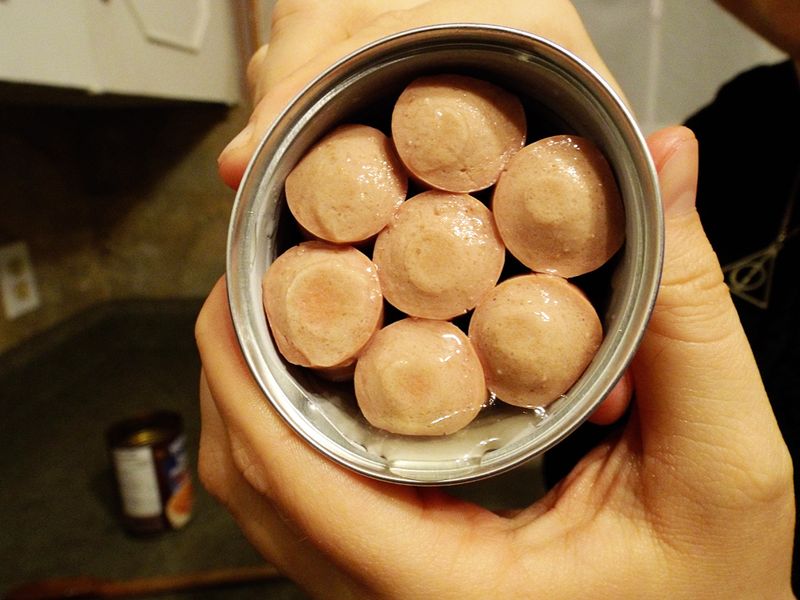
The ultimate convenience food of the 1940s combined two canned products into a meal that exemplified the era’s lowered culinary expectations. Pale, finger-sized Vienna sausages—with their distinctive rubbery snap and mysterious meat composition—were dumped into overly sweet canned beans to create a quick dinner solution.
The sausages, already soft from processing and canning, became even mushier when heated with the beans. Their bland flavor contributed little beyond a vague meatiness to the dish. Children would often fish them out and arrange them in patterns on their plates, playing with food being more entertaining than eating it.
Families consumed this meal regularly during and after the war, when convenience began to outweigh taste as a priority in American kitchens. While canned beans have remained a pantry staple, Vienna sausages have rightfully been relegated to fishing bait and nostalgic curiosities.
Leave a comment